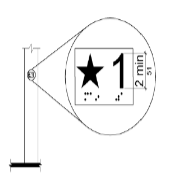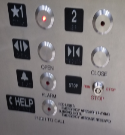Fire Service Recall Services Available Post

VDA Elevator Knowledge Center
From the Desk of George Gagle
Do you know that…
The Firefighters Emergency operation is the ability to automatically recall, or relocate, an elevator to its designated or alternate landings for firefighters or emergency personnel to gain control of an elevator during a fire or an emergency. Understanding this operation, what happens to elevators in an emergency and/or fire situation, and what to do can increase your odds of getting out of the building safely.
This operation was introduced into the elevator code in the late 1970s and has been enhanced and improved with the introduction of modern smart technology in the 21st century. If you are in a building built prior to the late 1970s, and the elevator has not been modernized, there may be a chance the elevator does not contain the Firefighters Emergency operation. An easy way to tell if an elevator has Firefighters Emergency operation is to look for a firefighters’ key switch and/or hat symbol will be located at the designated or main floor near the elevator lobby buttons (figure 1) or inside the elevator panel (figure 2).
During a fire emergency that affects the elevator, the firefighters’ hat will illuminate and the elevator will return to the designated or alternate landing. Once the elevator arrives, the doors will open to allow passengers to exit. After calmly exiting the elevator, passengers should proceed to the nearest building exit. Exiting the building quickly in an emergency situation is important, and to do so it is critical to understand the designated floor and possible exits.
When entering a building and walking towards an elevator you should look for the designated elevator floor, as this is the floor an elevator will likely return to in an emergency, and the floor you will need to exit the building from. There are a few ways to determine a designated floor. The first is the Firefighters’ operation key switch (figure 1) and can be seen while in the lobby area. This key switch is usually positioned next to the elevator call button. Second is a “star” graphic in the elevator Jamb (figure 3) or elevator entrance. The third and easiest to identify is the “star” graphic beside the floor buttons inside the elevator (figure 4). If possible, you should also note any building exits to ensure getting out of the building quickly. This is crucial and could save you time during an emergency situation.
Figure 1

Figure 2

Figure 3

Figure 4

In some rare cases, an elevator will return to the designated floor but the doors will only open partially or not at all. In this instance, you should press the door open button inside the cab (figure 4). If the doors still won’t open, use the emergency phone and call for help. Most modern elevators know where you are and which elevator, you’re in. You can also assist the operator by looking for the elevator number on the elevator operating panel. Pressing the emergency alarm button will direct emergency personal to your exact location.
Knowing what occurs under a fire or emergency situation and what to do while riding in an elevator is crucial to your safety and those with you.
VDA Is an all-inclusive elevator and escalator consulting firm providing services for the comprehensive maintenance design and engineering for elevators escalators moving walks dumbwaiters and lift systems in new and existing market segments.
To learn how VDA can help you on your next project, visit our Services page at https://vdassoc.com/service-offered/


